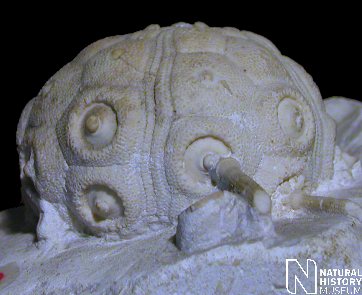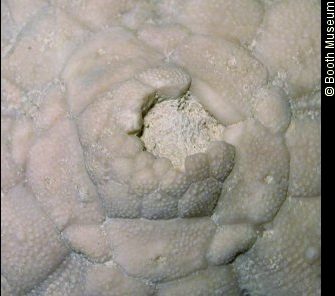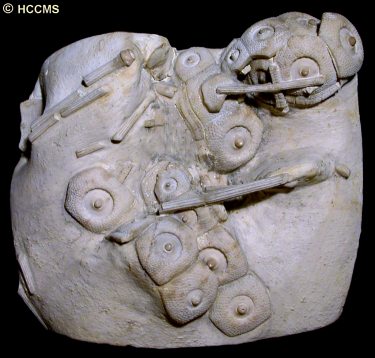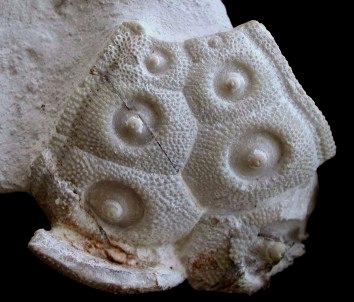 A A |
 B B |
|
Phalacrocidaris merceyi (Cotteau, 1862) |
This cidaroid is better recognised by its test than its primary spines. The adoral and ambital interambulacral plates have narrow areoles and broad regions of miliary tubercles, whilst above the ambitus the primary tubercles and areoles are reduced or absent. Primary spines are slender and elongate, with rows of highly reduced thorns. Small individuals are similar to Phalacrocidaris serrifera but can be arbitrarily distinguished by the number of rudimentary primary tubercles at the apical end of each interambulacral column; P. serrifera has one, P. merceyi has more than one (compare). Late Turonian to Early Santonian.
 A A |
 B B |
1). (A) Typical primary spine (Turonian, Washington, Sussex, x3). (B) Isolated ambital interambulacral plate displaying a broad region of miliary tubercles and a reduced areole (White Chalk, Beachy Head, Sussex, x3). Both Randell Collection, (A) RR0107, (B) RR1679.
 A A |
 B
B |
2). Apical views of complete tests with articulated spines and remarkably well preserved apical discs; (A) x1.3, White Chalk ('Senonian' (Coniacian-Campanian)), SE England, BMNH (British Museum (Natural History) London) E18595. Image © 2007 The Natural History Museum, by kind permission. (B) x1.5, Southerham, Lewes, Sussex, Booth Museum, BMB 007869, by kind permission of John Cooper.
 A
A |
 B
B |
3). Lateral (side) views of the above specimens; (A) - Fig. 2A, x1.5; (B) - Fig. 2B, x1.7. (A) Image © 2007 The Natural History Museum, by kind permission; (B) by kind permission of John Cooper.
|
|
 B B |
4). Apical details of the above specimens showing remarkably well preserved apical discs A) - Fig. 2A, x2.0; (B) - Fig. 2B, x3.5. (A) Image © 2007 The Natural History Museum, by kind permission; (B) by kind permission of John Cooper.

5). (A) Side view of the above specimen, x1.7. (B) A remarkably preserved individual with a largely complete compliment of spines. This is probably Phalacrocidaris merceyi, but could possibly be the closely related Phalacrocidaris serrifera. However, the diagnostic characteristics of the test are not exposed (x3.5, Potter collection, Booth Museum, BMB 011379, by kind permission of John Cooper).
 A A |
|
6). Complete test with a partial articulated spine compliment. (A) Adoral view, in need of further preparation, (B) Lateral view (x2.7, Hampshire?, White Chalk, HCCMS (Hampshire County Council Museum's Service) collection, stored at Gosport Museum, GOS1983.402, by kind permission of Dave Kemp, HCCMS).

7). Collapsed test and spines (x1.2, White Chalk, HCCMS (Hampshire County Council Museum's Service) collection, stored at Gosport Museum, GOS1984.351, by kind permission of Dave Kemp, HCCMS).
 A A |
|
8). (A) adoral view of an isolated test segment (x4, Beachy Head, White Chalk, Randell Collection, RR0494). (B) Well preserved association of scrobicular spines (x6.0, Hampshire?, White Chalk, HCCMS (Hampshire County Council Museum's Service) collection, stored at Gosport Museum, GOS1983.402, by kind permission of Dave Kemp, HCCMS).
* BMNH guide to Phalacrocidaris merceyi.
* BMNH guide to Phalacrocidaris.